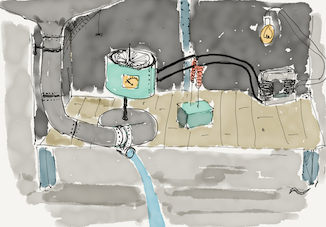 Renewable energy resources used to be called "alternative" sources of energy, but are quickly becoming mainstream.
Renewable energy resources used to be called "alternative" sources of energy, but are quickly becoming mainstream.
As a rule of thumb, a source of energy is renewable if it can be replaced in a human lifetime, or as quickly as it is used.
As you learn about each type of energy resource, consider:
- How it works
- The energy transfers involved
- Advantages/disadvantages
Key Concepts
Biomass
Fossil fuels take millions of years to form (dead animals into oil and dead plants into coal). This is a problem as mankind is now using these resources far faster than they are naturally produced.
Wood and vegetable oil, on the other hand, can be grown as fast as they are used. They are also carbon neutral.
Solar
Solar heating is the use of the Sun's infrared radiation to directly heat household water. To optimise heat transfer, solar heating pipes are painted black, placed om the roof, and twisted into a large surface area.
The photovoltaic cell is made of a sandwich of two types of semiconductor material. Sunlight excites electrons in the upper layer due to the photoelectric effect. This movement of electrons is an electric current.
A solar power station reflects sunlight onto a furnace where water is boiled. This connects up to the rest of a typical Power station by using the steam to turn a turbine and generator.
Hydroelectric
The principle of hydroelectric power is quite simple. The potential energy stored in the water in high mountain lakes can be converted to electricity when the kinetic energy of water flowing downhill turns a turbine connected to a generator.
In a pumped storage system, excess electricity is used to pump water back up the mountain. This does not produce energy but stores it as the water can be used to drive a turbine when high demand is anticipated.
Wind
Wind has kinetic energy. This can be used to provide a wind turbine with rotational kinetic energy, which can be converted into electricity if connected to a generator.
The kinetic energy of a cylinder (radius r) of wind travelling at velocity v is given by the equation:
\(E_k={1\over2}\rho\pi r^2v^3\)

Tidal power
Some areas of coastline have such a big tidal range that the water flows like a river. The flow of water can be used to drive turbines, which are positioned horiztontally.
Note that this is different to wave power, where the crashing waves directly strike turbines on a vertical plane.
Almost all the renewable sources of energy are derived from the Sun's energy:
- Solar power - directly from the Sun (either infrared or high energy light)
- Hydro power - energy from the Sun evaporates water that later rains on high ground.
- Wind power - energy from the Sun heats air causing convection currents and wind.
- Wave power - high winds at sea disturb the surface of the water to give waves.
Tidal power - not the Sun. Tides are due to the rotational motion of the Earth under the influence of the gravitational attraction of the Moon.
How much of Renewable sources I have you understood?


 Twitter
Twitter  Facebook
Facebook  LinkedIn
LinkedIn